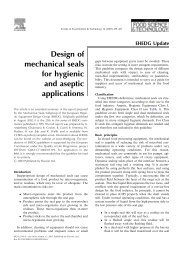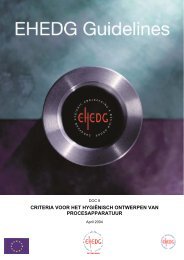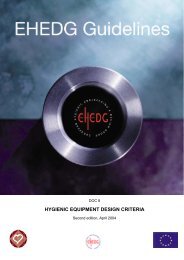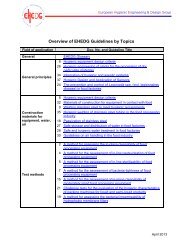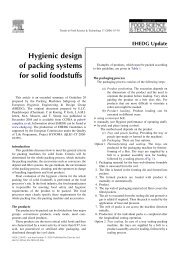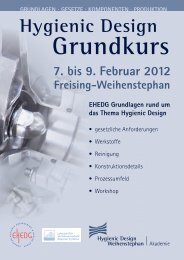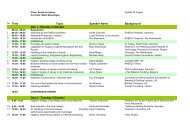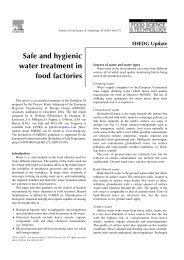Yearbook 2013/2014 - ehedg
Yearbook 2013/2014 - ehedg
Yearbook 2013/2014 - ehedg
You also want an ePaper? Increase the reach of your titles
YUMPU automatically turns print PDFs into web optimized ePapers that Google loves.
European Hygienic Engineering & Design Group<br />
Hygienic automation technology in food production<br />
How clean design automation products support food safety<br />
Alexander Wagner, Festo AG & Co. KG, Esslingen, Germany, e-mail: awn@de.festo.com, www.festo.com<br />
Protecting the consumer and the manufacturer’s brand are<br />
the key benefits of hygienic and efficient automation in food<br />
production. The aims are two-fold: high productivity and<br />
perfect tasting food.<br />
The key questions for food safety in the automation<br />
technology are:<br />
• What are the potential hazards in food production and<br />
processing?<br />
• What are the valid standards and directives for<br />
hygienic automation technology?<br />
• What standards are to be respected in the material<br />
selection and design for hygienic machinery<br />
components?<br />
• How are machinery parts in the food sector to be<br />
cleaned?<br />
• How is a hygienic food production system to be<br />
implemented?<br />
Recognising and preventing risks<br />
Salmonella in sausages, Listeria in cheese – the list of<br />
foodborne illness outbreaks and scandals is endless.<br />
Significant hazards in the food sector are caused by:<br />
• Biological factors: illness caused by microorganisms or<br />
their toxins<br />
• Chemical factors: cleaning and disinfecting agents and<br />
lubricants<br />
• Foreign particles: from machines, often caused by<br />
corrosion or abrasion, or from other sources<br />
When ensuring that a machine‘s design is hygienic, all<br />
known and potential hazards must be taken into account,<br />
and action must be taken to reduce these risks.<br />
Figure 1: Resistant surfaces and a high IP protection class, such<br />
as those of the pneumatic valve terminal CDVI, are component<br />
features that meet requirements for hygiene regulations.<br />
Machinery Directive 2006/42/EC<br />
This directive focuses on health and safety requirements<br />
put in place to protect machinery operators. Possible risks<br />
should be eliminated. Special hygiene requirements apply to<br />
machinery intended for the preparation and handling of food.<br />
The machinery must be designed and constructed in such a<br />
way as to avoid any risk of infection, sickness or contagion.<br />
This directive forms the basis for the EC conformity mark.<br />
The basics – standards and directives<br />
Standards and directives form the basis that allows people<br />
to enjoy food with reduced risk of adverse health effects from<br />
consuming contaminated products (Table 1). Implementing<br />
these regulations during production reduces the risks for the<br />
manufacturer and the consumer. The aim of the European<br />
Commission (EC) Machinery Directive 2006/42/EC is the<br />
protection and safety of consumers and operators wherever<br />
food comes into direct contact with machine parts and<br />
components. The application of standards and directives<br />
for design (EN 1672-2 and European Hygienic Engineering<br />
& Design Group [EHEDG] Documents 8 and 13) and<br />
materials (US Food and Drug Administration [FDA] Code of<br />
Regulations Title 21, International Standards Organisation<br />
[ISO] 21469, and EC Regulation1935/2004/EC) provide<br />
additional support for food safety.<br />
Figure 2: The threadless design for the bearing cap as it is used<br />
in the stainless steel round cylinder CRDSNU reduces the risk<br />
of contamination. In addition, the self-adjusting end position<br />
cushioning system is designed without adjusting screws, which are<br />
susceptible to contamination.



